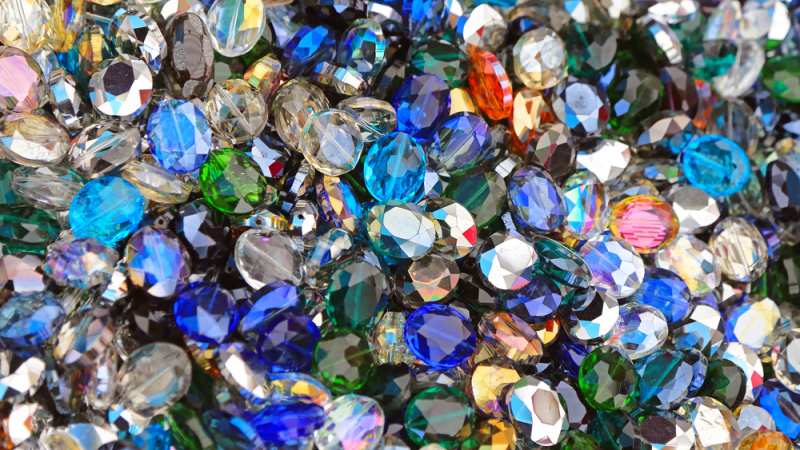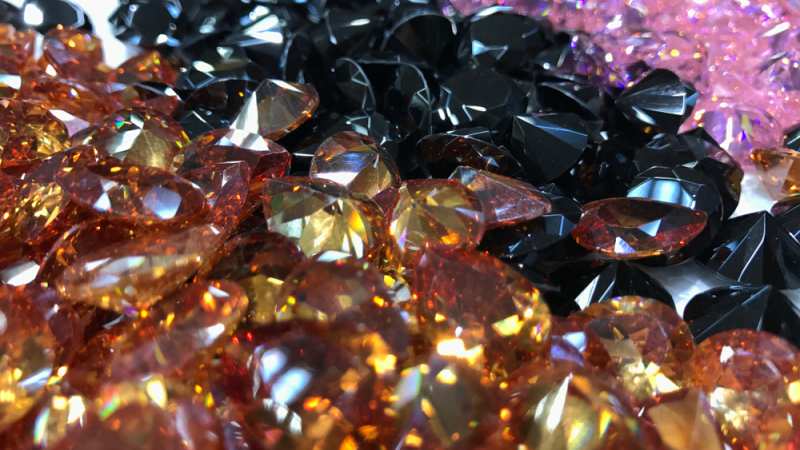Cubic zirconia, despite its striking resemblance to diamonds, possesses certain hidden flaws that may not be immediately apparent.
In this guide, we will explore how cubic zirconia is formed and whether the average person can distinguish it from real diamonds. We will also compare the two in terms of their various properties and examine their durability.
So, if you’re curious to find out the winner in the ongoing battle between cubic zirconia and diamonds, keep scrolling and let’s uncover all the answers to these questions and more!
DESIGN YOUR OWN ENGAGEMENT RING: START WITH A SETTING OR START WITH A DIAMOND. IT’S REALLY UP TO YOU!

What Is A Diamond? What Is A Cubic Zirconia?
Cubic zirconia has long been the synthetic substitute of choice for natural diamonds. However, there are significant differences between the two, starting with their formation processes.
Natural diamonds are composed of carbon and are the hardest naturally occurring substance. They are formed deep within the Earth, about 100 miles below the surface, under high temperatures and pressure exerted by surrounding rocks. Unfortunately, due to the inaccessibility of this part of the Earth, the complete process of diamond formation remains unknown. Diamonds are brought to the surface through violent volcanic eruptions, preserved within a mound of volcanic material called Kimberlite. This eruption must have happened rapidly to prevent the diamonds from transforming into graphite.
On the other hand, cubic zirconia, often abbreviated as CZ, is a synthetic gem made of cubic crystalline form of zirconium dioxide (ZrO2). It should not be confused with zirconium, a silver-grayish metal, or zircon, which is zirconium silicate (ZrSiO4). The natural form of zirconium oxide, known as baddeleyite, is different from cubic zirconia in terms of crystal structure. Baddeleyite is a monoclinic crystal, whereas cubic zirconia has a cubic (isometric) crystal structure similar to that of a diamond. This similarity in crystal structure contributes to the hardness of cubic zirconia.
While cubic zirconia is a synthetic diamond simulant, it is essential to note that the natural form of zirconium oxide, baddeleyite, has been known since 1892. Baddeleyite is mined in various countries, including the United States, Australia, Brazil, South Africa, Russia, and Sri Lanka.
Considering these distinctions, the question arises: Is cubic zirconia considered a real gem?

Is Cubic Zirconia A Natural Gem?
No, cubic zirconia is not considered a real gemstone. Gemstones are categorized into three groups: natural, synthetic, and simulant.
Natural gemstones are cut from various crystalline minerals, including diamonds and quartz, as well as organic materials like fossils, amber, coral, or pearls.
Synthetic gemstones are grown in laboratories and possess the same appearance, chemical composition, and physical and optical properties as their natural counterparts. Examples of synthetic gemstones include emerald, ruby, sapphire, and many others.
Simulant gemstones, like cubic zirconia, are also lab-grown but have similar appearances to natural gems while exhibiting different optical, physical, and chemical properties.
To understand how cubic zirconia is made, let’s explore the process. The primary ingredient is zirconium dioxide in powdered form, which is stabilized with magnesium, calcium, and other additives to achieve a natural-like appearance. The specific amounts of each ingredient may vary among manufacturers.
A technique called the skull melting system, using a paper cup with circulating water, is employed due to the high melting point of the mineral. The powdered mixture is placed inside the cup, and radiofrequency heating melts the powder. The part closest to the cooling water remains solid while surrounding the melted portion.
After cooling, crystals begin to form and grow until the melted part solidifies. Similar to diamonds, cubic zirconia undergoes a cutting process where the cutter determines the optimal shape to achieve maximum clarity and utilization of the crystal.
Interestingly, cubic zirconia does have cubes within its internal structure. When there are sufficient crystalline forms of zirconium dioxide, the molecules stack together in a cube shape, similar to salt crystals. Regardless of the specific shape of the cubic zirconia stone, its internal structure remains the same, visible only under a microscopic scale.

Different Properties Of Cubic Zirconia & Diamonds – Comparison
Let’s compare the two gems side by side and see how they stack up against each other.
Hardness
On the hardness scale, cubic zirconia (CZ) ranks between 8.5 and 9, while genuine diamonds score a perfect 10. Diamonds are known as the hardest natural substance on Earth.
Brilliance
Brilliance refers to the amount of white light that reflects off the surface of a gem and returns to the observer’s eye. The reflective index measures the gem’s ability to reflect light in different colors. CZ has an index of 2.15-2.18, whereas a genuine diamond has a higher value of 2.42.
This difference in index means that cubic zirconia lacks the same brilliance and colored light reflection as a diamond, and it can’t match a diamond’s sparkle.
Color
Both diamonds and cubic zirconia can be found in a variety of colors. The colors range from the palest yellows to brilliant reds. In diamonds, color is typically influenced by the cut and formation, while oxide mixtures can affect the color of CZ. However, variations in color can result in undesired uneven coloring in both stones.
Cubic zirconia is naturally colorless and can appear “too perfect” to some consumers and experts. Some manufacturers even produce colored tints and inclusions in CZ to make them resemble diamonds more closely.
Carat
There is a notable density difference between diamonds and cubic zirconia, with the latter being 1.7 times denser. As a result, a one-carat CZ gem would have different dimensions than a one-carat diamond. The higher density of CZ means that a CZ gem with the same weight as a one-carat diamond would be smaller in size.
Cut
The cut of a gem is crucial in determining its value and properties. In 1919, Marcel Tolkowsky established the ideal proportions for cutting diamonds to maximize their fire and brilliance. This cut, known as the brilliant cut, is still considered the most objective and measurable standard. It consists of 58 facets cut at mathematically-determined angles to optimize light reflection. The proportions and finish grades of a gemstone, including both diamonds and CZ, are assessed based on their deviation from this standard.
Clarity
Clarity refers to the transparency or clearness of a gem. In diamonds, clarity is determined by natural factors such as trace minerals and imperfections. Generally, the clearer the diamond, the more valuable it is. For CZ, which is lab-grown, slight random inclusions can occur due to variations in the oxide mixture. However, these inclusions are considered flaws resulting from poor laboratory work. Otherwise, CZ is known for its near-perfect clarity.
Shape
While there are various shapes available for both diamonds and cubic zirconia, the classic round shape offers the best dispersion, brilliance, and fire in both gems.
By considering these factors, we can better understand the similarities and differences between diamonds and cubic zirconia.

CZ Vs. Diamonds: Value Differences
There are additional factors that contribute to the difference in value between diamonds and cubic zirconia:
Origin and Age: Diamonds have been forming on Earth for billions of years, with some dating back to hundreds of millions of years. Scientists can determine the age of a diamond through mineral inclusions. On the other hand, cubic zirconia has only been available on the market since 1976.
Moissanite: Moissanite is another popular diamond substitute, and it has been around since 1998. It is considered the closest rival to cubic zirconia in terms of composition and appearance. However, like cubic zirconia, moissanite can sometimes appear “too perfect.”
Formation Time: The natural formation process of diamonds is still not fully understood, and it may take millions of years. The formation of diamonds is not continuous and can be influenced by changing conditions. In contrast, cubic zirconia can be created within a relatively short period under controlled laboratory conditions.
The Difference in Manufacturing: The variation in manufacturing processes is a significant factor in the vast difference in cost. Diamonds, being naturally formed over an extended period, can cost from a few to tens of thousands of dollars per carat. On the other hand, a cubic zirconia of good quality typically costs from a few tens to a hundred dollars per carat.
Understanding these factors helps to explain the disparity in value between diamonds and cubic zirconia.

Cubic Zirconia Vs. Diamond – Is The Difference Visible?
If you want to distinguish between a real diamond and cubic zirconia, there is a simple test you can do at home. Observing the stones under natural light is the best way to spot a visible difference. Diamonds emit a white light known as brilliance, while cubic zirconia emits rainbow-colored light, indicating excessive light dispersion.
However, it’s important to note that both diamonds and cubic zirconia can scratch glass, so using this method may not be foolproof.
There are other reliable methods available to test a diamond’s authenticity, such as using a diamond tester to measure its thermal or electrical conductivity. However, it’s worth mentioning that in rare cases, these testing devices can be deceived or provide inaccurate results.

Bottom Line
By now, you have become familiar with all the differences that will help you make a decision in the ongoing competition between cubic zirconia and diamond.
Cubic zirconia offers a vibrant and colorful sparkle, impeccable clarity, and a wide range of available colors. Most importantly, it is an affordable option for the average person. On the other hand, diamonds possess a timeless reputation, guaranteed uniqueness, and are renowned for their longevity.
If the origin of the gem and frequency of wear are not major concerns for you, then the choice ultimately comes down to your personal preference and taste!
If you’re still uncertain, consider this: cubic zirconia was considered “good enough” to create a flawless replica of the famous Hope Diamond, which currently stands side by side with the original at the Smithsonian Institute.
This certainly speaks volumes about the quality and appeal of these diamond substitutes!


